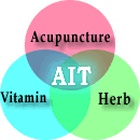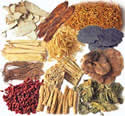Acupuncture
The
theory of acupuncture is base on Channels, Collaterals ( called
Meridians ) and Acupoints. The Channels and collaterals
are comprehensively termed "Jinglou" in Traditional
Chinese Medicine ( TCM ). The Channels, meaning paths, are the
main trunks which run longitudinaly and interiorly-exteriorly within
the body; while the Collaterals, meaning networks, thinner and
smaller than Channels, are branches which run crisscrossly over the
body. The theory of Channels and Collaterals deals with the courses
and distributions, physiological functions, pathological changes of
channels and collaterals of the human body, and their relations to th
e
Zang-Fu organs. The Acupoints are the sites through which
the Qi of the Zang- Fu organs and channels is transported
to the body surface.
Acupuncture
is an ancient technique in which a skilled practitioner inserts hair-thin
needles into these specific meridian points of the body for therapeutic
purposes. Acupuncture has proven remarkably effective, especially for
many diseases that are resistant to conventional forms of therapy. In
addition, acupuncture is free of side-effects. Practiced for thousands
of years in China where it originated, acupuncture is part of the holistic
system of Traditional Chinese Medicine (TCM) which views health as a
constantly changing flow of energy, or Qi (pronounced "chee").
Acupuncture helps regulate imbalances in this natural flow of energy,
which result in disease. It is also safe and economical.
Acupuncture treatment has been proven to manifest the following effects:
1.
Physiological Analgesic:
This pain-relieving effect significantly reduces headaches, trigerminal
neuralgia, arthritis pain, low backache and other pain caused by soft
tissue injury and degenerative changes.
2. Hastening Motor Recovery from Trauma or Paralysis:
Through the Biofeedback mechanism, acupuncture treatment stimulates
the anterior horn cells of the spinal cord as well as stimulating blood
circulation and muscle cells. This also enhances the recovery of certain
types of paralysis and trauma.
3. Enhancing Immunity:
Immunology studies show that the level or activity of leucocytosis,
T cells, antibodies, interferon and reticuloendothelial has been re-enforced
with acupuncture treatment. These mechanisms also help the body against
infection and relieve allergic symptoms.
4. Homeostasis :
Homeostasis is maintained by the balanced activity of the nervous, endocrine,
respiration, blood circulation, digestion and excretion systems, as
well as others. These mechanisms are seriously deranged by many diseases,
and acupuncture is extremely helpful in re-establishing and maintaining
their balance.
5. Reduction of Body Fat and Cessation of Smoking:
Numerous cases prove that acupuncture is effective in stopping smoking
and losing significant body weight. Since the 1960's, the popularity
of acupuncture in the West has increased significantly. Its beneficial
effects, particularly as a method of pain relief, are now widely recognized.
Alongside professional acupuncturists, a number of western medical practitioners
such as General Practice Doctors, Physiotherapists and Osteopathy Specialists,
who have received special training, have incorporated the use of a Westernized
style of acupuncture in their existing treatments.
The
needles contact and regulate an inner force called Qi. The changes in
Qi caused by inserting the needles create changes in your internal environment
and restore your health. In the first step, the acupuncturist examines
a system of naturally flowing Qi energies. These energies should function
like invisible maintenance crews whose many tasks keep the body running
smoothly, because Qi is behind every physiological and psychological
function - from blood circulation to the prevention of emotional hysteria.
If Qi is no longer flowing well, an ailment will be evident. As a second
step, the acupuncturist then guides the action of the needles to return
the inner workings to as normal a state as possible. The needles actually
perform more than one hundred and fifty different kinds of healing activities,
such as releasing blockages and restoring strength.
Disorders of 12 meridian:
Syndrome
of The Lung Meridian:
Cough, asthmatic breathing, hemoptysis, congested and sore throat, a
sensation of fullness in the chest ; pain in the supraclavicular fossa,
shoulder, back and anterior border of the medial aspect of the arm.
Syndrome of The Large Intestine Meridian:
Epistaxis, watery nasal discharge, toothache, congested and sore throat
; pain in the neck, anterior part of the shoulder and anterior border
of the lateral aspect of the upper limb ; borborygmus, abdominal pain,
diarrhea and dysentery.
Syndrome of The Stomach Meridian:
Borborygmus, abdominal distension, edema, epigastric pain, vomiting,
hunger, epistaxis, deviation of the mouth, congested and sore throat
; pain in the chest, abdomen and lateral aspect of the lower limbs ;
fever and mania.
Syndrome of the Spleen Meridian :
Belching, vomiting, epigastric pain, abdominal distension, loose stools,
jaundice, heaviness of the body, lassitude, stiffness and pain in the
root of the tongue, swelling and coldness in the medial aspect of the
thigh and knee.
Syndrome of The Heart Meridian:
Cardiac pain, palpitations, hypochondriac pain, insomnia, night sweating,
dryness of the throat, thirst, pain in the medial aspect of the upper
arm and heat sensation in the palms.
Syndrome of The Small Intestine Meridian:
Deafness, yellow sclera, sore throat, swelling of the cheeks, distension
and pain in the lower abdomen and pain in the posterior border of the
lateral aspect of the shoulder and arm.
Syndrome of The Bladder Meridian:
Retention of urine, enuresis, manic and depressive mental disorders,
malaria, pain of the eyes, lacrimation when exposed to wind, nasal obstruction,
rhinorrhea, epistaxis, headache ; and pain in the nape, back, low back,
buttocks and posterior aspect of the lower hmbs.
Syndrome of The Kidney Meridian :
Enuresis, frequent urination, nocturnal emission, impotence, irregular
menstruation, asthmatic breathing, hemoptysis, dryness of the tongue,
congested and sore throat, edema, pain in the lumbar region and in the
posteriomedial aspect of the thigh, weakness of the lower limbs and
heat sensation in the soles.
Syndrome of The Pericardium Meridian:
Cardiac pain, palpitations, mental restlessness, stuffiness in the chest,
flushed face, swelling in the axilla, depressive and manic mental disorders,
spasm of the upper limbs and heat sensation in the palms
Syndrome of the SanjiaoMeridian :
Abdominal distension, edema, enuresis, dysuria, deafness, tinnitus,
pain in the outer canthus, swelling of the cheeks, congested and sore
throat ; and pain in the retroauricular region, shoulder, and lateral
aspect of the arm and elbow.
Syndrome of The Gallbladder Meridian :
Headache, pain in the outer canthus, pain in the jaw, blurring of vision,
bitter taste in the mouth, swelling and pain in the supraclavicular
fossa, pain in the axilla ; and pain along the lateral aspect of the
chest, hypochondrium, thigh and lower limbs.
Syndrome of The Liver Meridian
Low back pain, fullness in the chest, pain in the lower abdomen, hernia,
vertical headache, dryness of the throat, hiccups, enuresis, dysuria
and mental disturbance.
Acupuncture
treatment stimulates specific acupuncture points and treats local problems,
at the same time following the meridians to treat distant problems and
related organs. Different
symptoms come from different disorders of the meridian,
so the benefit of acupuncture therapy is to treat both symptom and original
cause at the same time and not just to attack the symptoms.

